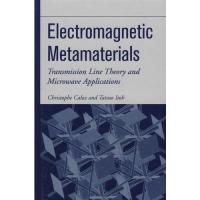| 定价: | ¥ 1008 | ||
| 作者: | Christophe Caloz, Tatsuo Itoh 著 | ||
| 出版: | 吉林长白山 | ||
| 书号: | 9780471669852 | ||
| 语言: | 英文原版 | ||
| 日期: | 2005-11-01 | ||
| 版次: | 1 | 页数: | 352 |
| 开本: | 16开 | 查看: | 0次 |

| 服务商城 | 客服电话 | 配送服务 | 优惠价 | 购买 |
| 400-711-6699 | 满29至69元,免运费! | ¥907.2 |
This book presents an original generalized transmission line approach associated with non-resonant structures that exhibit larger bandwidths, lower loss, and higher design flexibility. It is based on the novel concept of composite right/left-handed (CRLH) transmission line metamaterials (MMs), which has led to the development of novel guided-wave, radiated-wave, and refracted-wave devices and structures.
Preface
Acknowledgments
Acronyms
1 Introduction
1.1 Definition of Metamaterials (MTMs) and Left-Handed (LH) MTMs,
1.2 Theoretical Speculation by Viktor Veselago,
1.3 Experimental Demonstration of Left-Handedness,
1.4 Further Numerical and Experimental Confirmations,
1.5 "Conventional" Backward Waves and Novelty of LH MTMs,
1.6 Terminology,
1.7 Transmission Line (TL) Approach,
1.8 Composite Right/Left-Handed (CRLH) MTMs,
1.9 MTMs and Photonic Band-Gap (PBG) Structures,
1.10 Historical "Germs" of MTMs,
References,
2 Fundamentals of LH MTMs
2.1 Left-Handedness from Maxwell's Equations,
2.2 Entropy Conditions in Dispersive Media,
2.3 Boundary Conditions.
2.4 Reversal of Doppler Effect,
2.5 Reversal of Vavilov-Cerenkov Radiation,
2.6 Reversal of Snell's Law: Negative Refraction,
2.7 Focusing by a "Flat LH Lens",
2.8 Fresnel Coefficients,
2.9 Reversal of Goos-Hanchen Effect,
2.10 Reversal of Convergence and Divergence in Convex and Concave Lenses,
2.11 Subwavelength Diffraction,
References,
3 TL Theory of MTMs
3.1 Ideal Homogeneous CRLH TLs,
3.1.1 Fundamental TL Characteristics,
3.1.2 Equivalent MTM Constitutive Parameters,
3.1.3 Balanced and Unbalanced Resonances,
3.1.4 Lossy Case,
3.2 LC Network Implementation,
3.2.1 Principle,
3.2.2 Difference with Conventional Filters,
3.2.3 Transmission Matrix Analysis,
3.2.4 Input Impedance,
3.2.5 Cutoff Frequencies,
3.2.6 Analytical Dispersion Relation,
3.2.7 Bloch Impedance,
3.2.8 Effect of Finite Size in the Presence of Imperfect
Matching,
3.3 Real Distributed ID CRLH Structures,
3.3.1 General Design Guidelines,
3.3.2 Microstrip Implementation,
3.3.3 Parameters Extraction,
3.4 Experimental Transmission Characteristics,
3.5 Conversion from Transmission Line to Constitutive Parameters,References,
4 two-Dimensional MTMs
4.l Eigenvalue Problem,
4.1.1 General Matrix System,
4.1.2 CRLH Particularization,
4.1.3 Lattice Choice, Symmetry Points, Brillouin Zone, and 2D
Dispersion Representations,
4.2 Driven Problem by the Transmission Matrix Method (TMM),
4.2.1 Principle of the TMM,
4.2.2 Scattering Parameters,
……
5 Guided-Wave Applications
6 Radiated-Wave Applications
7 The Future of MTMs
Index
Acknowledgments
Acronyms
1 Introduction
1.1 Definition of Metamaterials (MTMs) and Left-Handed (LH) MTMs,
1.2 Theoretical Speculation by Viktor Veselago,
1.3 Experimental Demonstration of Left-Handedness,
1.4 Further Numerical and Experimental Confirmations,
1.5 "Conventional" Backward Waves and Novelty of LH MTMs,
1.6 Terminology,
1.7 Transmission Line (TL) Approach,
1.8 Composite Right/Left-Handed (CRLH) MTMs,
1.9 MTMs and Photonic Band-Gap (PBG) Structures,
1.10 Historical "Germs" of MTMs,
References,
2 Fundamentals of LH MTMs
2.1 Left-Handedness from Maxwell's Equations,
2.2 Entropy Conditions in Dispersive Media,
2.3 Boundary Conditions.
2.4 Reversal of Doppler Effect,
2.5 Reversal of Vavilov-Cerenkov Radiation,
2.6 Reversal of Snell's Law: Negative Refraction,
2.7 Focusing by a "Flat LH Lens",
2.8 Fresnel Coefficients,
2.9 Reversal of Goos-Hanchen Effect,
2.10 Reversal of Convergence and Divergence in Convex and Concave Lenses,
2.11 Subwavelength Diffraction,
References,
3 TL Theory of MTMs
3.1 Ideal Homogeneous CRLH TLs,
3.1.1 Fundamental TL Characteristics,
3.1.2 Equivalent MTM Constitutive Parameters,
3.1.3 Balanced and Unbalanced Resonances,
3.1.4 Lossy Case,
3.2 LC Network Implementation,
3.2.1 Principle,
3.2.2 Difference with Conventional Filters,
3.2.3 Transmission Matrix Analysis,
3.2.4 Input Impedance,
3.2.5 Cutoff Frequencies,
3.2.6 Analytical Dispersion Relation,
3.2.7 Bloch Impedance,
3.2.8 Effect of Finite Size in the Presence of Imperfect
Matching,
3.3 Real Distributed ID CRLH Structures,
3.3.1 General Design Guidelines,
3.3.2 Microstrip Implementation,
3.3.3 Parameters Extraction,
3.4 Experimental Transmission Characteristics,
3.5 Conversion from Transmission Line to Constitutive Parameters,References,
4 two-Dimensional MTMs
4.l Eigenvalue Problem,
4.1.1 General Matrix System,
4.1.2 CRLH Particularization,
4.1.3 Lattice Choice, Symmetry Points, Brillouin Zone, and 2D
Dispersion Representations,
4.2 Driven Problem by the Transmission Matrix Method (TMM),
4.2.1 Principle of the TMM,
4.2.2 Scattering Parameters,
……
5 Guided-Wave Applications
6 Radiated-Wave Applications
7 The Future of MTMs
Index





 粤公网安备 44030902003195号
粤公网安备 44030902003195号